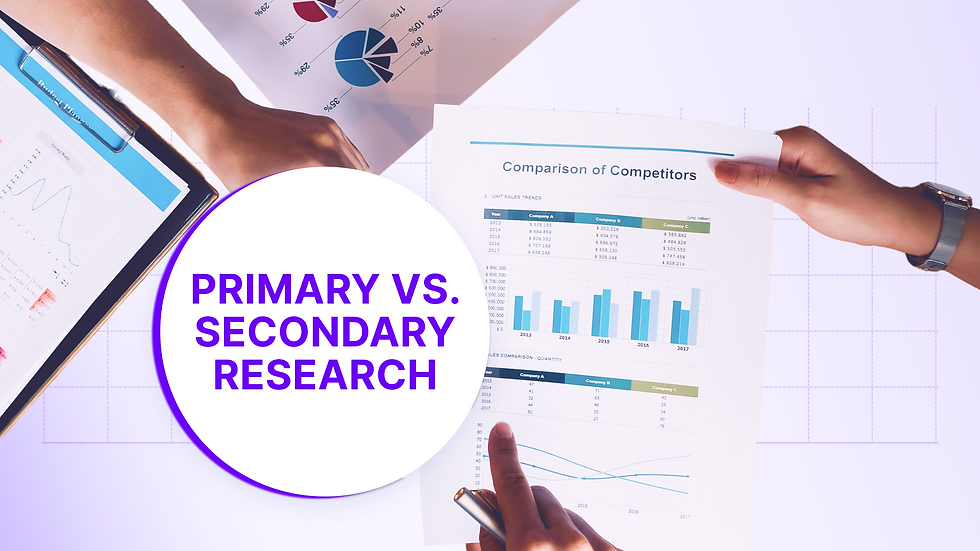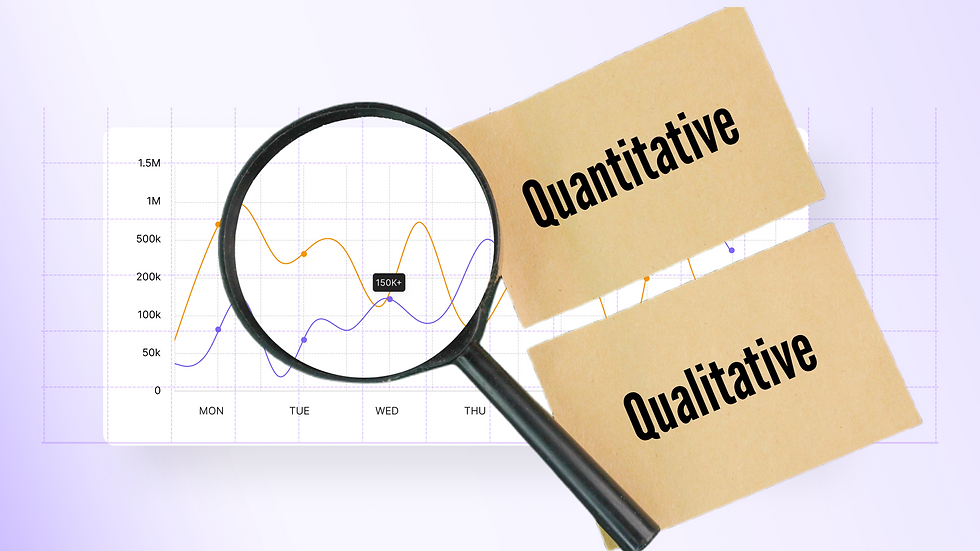It's no news that understanding consumer behaviour is more crucial than ever. Businesses & brands must make informed decisions to cater to their audience’s evolving needs. Consumer research plays a pivotal role in this process by uncovering key consumer insights, shaping marketing strategies, and optimising product development.
In this blog, we'll explore the different types of consumer research, their methods, and when to use them effectively, ensuring you can make data-driven decisions to stay ahead.
Primary vs. Secondary Research

What is Primary Research?
Primary research involves collecting original data directly from consumers. This method is tailored to a business’s specific needs and is conducted through surveys, interviews, or focus groups. The data collected is called primary data, which is new, exclusive, and customised for your research objectives.
Benefits of Primary Research:
Direct feedback: Provides firsthand insights into consumer behaviour, ensuring relevance and specificity.
Customised research: Offers tailored data collection to address specific business needs.
When to Use Primary Research:
Primary research is ideal when your business needs specific insights about consumer behaviour, preferences, or reactions to a new product. It’s particularly valuable for gathering primary and secondary data in research.
What is Secondary Research?
Secondary research, on the other hand, involves analysing data that has already been collected, such as industry reports, academic studies, or a research paper on the buying behaviour of consumers. This method is often more affordable and time-efficient as it leverages pre-existing data.
Benefits of Secondary Research:
Cost-effective: Access to ready-made data reduces research costs.
Broad insights: It provides a macro view of the market, including trends and general consumer behaviours.
When to Use Secondary Research:
Secondary research is useful when you’re exploring a new market or need background information to complement your primary research. It provides an efficient way to understand market trends and consumer preferences.
Quantitative vs. Qualitative Research

Quantitative Research
Quantitative research focuses on numerical data, often gathered through surveys or structured questionnaires. This type of research helps businesses measure and analyse consumer behaviour in a statistically meaningful way. It is particularly useful when dealing with large sample sizes and aims to produce objective, measurable data.
Benefits of Quantitative Research:
Data scalability: Quantitative research allows for generalising results across a broader population.
Objective insights: Data-driven results provide clear, unbiased insights.
When to Use Quantitative Research:
Quantitative research is ideal when you need to analyse consumer preferences in measurable terms. For example, you can use it to study trends in a research paper on the buying behaviour of consumers or when you need to track consumer satisfaction levels.
Qualitative Research
Qualitative research is more exploratory and focuses on the deeper motivations behind consumer behaviours. Common methods include interviews and focus groups, which allow businesses to gain a more profound understanding of consumer preferences, thoughts, and feelings.
Benefits of Qualitative Research:
Detailed insights: It uncovers the ‘why’ behind consumer actions, providing rich, descriptive data.
Flexibility: Open-ended questions allow for more in-depth responses.
When to Use Qualitative Research:
This type of research is most useful in product development, brand positioning, or when exploring consumer insights that go beyond numerical data.
Methods of Consumer Research

Surveys
Surveys are a staple of consumer research and are particularly effective for collecting quantitative data. They offer a structured format to ask specific questions, allowing businesses to capture a wide range of consumer responses.
Benefits of Surveys:
Efficient data collection: Surveys can reach large numbers of people quickly, gathering significant amounts of primary data.
Data analysis: The structured format makes responses easy to analyse and compare.
When to Use Surveys:
Surveys are best used when you need to quantify consumer behaviour or opinions. For example, they’re useful for gathering data in a research paper on consumers' buying behaviour.
Focus Groups
Focus groups are a qualitative research method where small groups of consumers discuss a product, service, or brand. This method allows for an interactive exploration of consumer perceptions and opinions, often uncovering insights that aren’t immediately visible in quantitative data.
Benefits of Focus Groups:
In-depth feedback: They provide detailed insights into consumer thoughts and feelings.
Interactive discussion: Consumers can respond to each other’s feedback, enriching the conversation.
When to Use Focus Groups:
Focus groups are ideal for exploring consumer insights on a deeper level. They are particularly effective in the early stages of product development, branding exercises, or marketing message testing.
Observational Studies
In observational research, consumers are observed in natural settings to see how they interact with products or services. Unlike surveys or focus groups, observational studies allow businesses to capture real-world consumer behaviour without any interference.
Benefits of Observational Studies:
Unbiased data: Because consumers aren’t directly interacting with researchers, their behaviour is more natural and less biased.
Real-world context: Observational studies provide insight into how products are used in everyday situations.
When to Use Observational Studies:
This method is ideal when you want to see how consumers use your product in a natural environment. It’s particularly useful when behavioural insights are crucial, such as during product design phases.
Conclusion
Understanding the different types of consumer research can empower your business to make more informed decisions. Whether you’re conducting primary research to gather specific data from your target audience or secondary research to analyse existing data, each method provides valuable insights. Combining both quantitative and qualitative research ensures a well-rounded understanding of consumer behaviour, leading to more effective business strategies.
By leveraging methods like surveys, focus groups, and observational studies, you can gather consumer insights that drive innovation, improve customer satisfaction, and, ultimately, fuel business growth. Make the most of your research efforts to stay ahead of the competition and better meet the needs of your consumers.
Comments